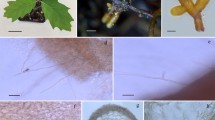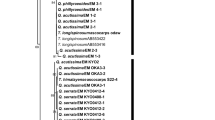Abstract
Tuber macrosporum Vittad. is not a common truffle species, but with remarkable organoleptic qualities and much economic interest. After the addition of truffle spore slurry, 30 seedlings of Quercus robur L., Quercus cerris L. and Corylus avellana L. were grown inside a greenhouse for 11 months before evaluation of the mycorrhizal level. Two different potting mixes were used: a natural soil-based potting mix for Q. robur, Q. cerris and C. avellana and a peat-based potting mix for Q. robur. Quercus robur planted in soil potting mix was the most receptive towards the truffle spore inoculum, with a level of formation of T. macrosporum ectomycorrhizas (ECMs) of approximately 14 %, ranging from a minimum of ∼4 % to a maximum of ∼44 % in different seedlings. No T. macrosporum ECMs developed on Q. cerris (soil potting mix) or on Q. robur (peat potting mix), whereas a low percentage of ECMs was detected on only three C. avellana (soil potting mix) seedlings. The fungus Sphaerosporella brunnea (Alb. & Schwein.) Svrček & Kubička was also detected as a contaminant on almost half the truffle-inoculated seedlings. A new detailed description of the morphological and anatomical characteristics of T. macrosporum ECMs and their DNA-based verification with species-specific markers were also reported.



Similar content being viewed by others
References
Agerer R (1987–2008) Colour atlas of ectomycorrhizae, 14th edn. Einhorn, Scwäbisch Gmünd (separate pagination)
Agerer R (1991) Characterization of ectomycorrhiza. In: Norris JR, Read DJ, Varma AK (eds) Methods in microbiology: techniques for the study of mycorrhiza. Academic, San Diego, pp 25–73
Angelini P, Costamagna L, Ciani M (1998) Ecologia batterica di ascocarpi di Tuber sp. pl.: individuazione di gruppi funzionali e valutazione delle capacità di metabolizzare solfiti e composti organici solforati. Ann Microb 48:59–65
Avis PG, McLaughlin DJ, Dentinger BC, Reich PB (2003) Long term increase in nitrogen supply alters above- and belowground ectomycorrhizal communities and increases the dominance of Russula spp. in a temperate oak savanna. New Phytol 160:239–253. doi:10.1046/j.1469-8137.2003.00865.x
Bencivenga M, Donnini D, Tanfulli M, Guiducci M (1995a) Tecnica di campionamento delle radici e degli apici radicali per la valutazione delle piante micorrizate. Micol Ital 2:35–47
Bencivenga M, Di Massimo G, Donnini D, Tanfulli M (1995b) Micorrize inquinanti frequenti nelle piante tartufigene. Nota 1 inquinanti in vivaio. Micol Ital 2:167–178
Benucci GMN, Bonito G, Baciarelli-Falini L, Bencivenga M (2011a) Mycorrhization of Pecan trees (Carya illinoinensis) with commercial truffle species: Tuber aestivum Vittad. and Tuber borchii Vittad. Mycorrhiza. doi:10.1007/s00572-011-0413-z
Benucci GMN, Raggi L, Di Massimo G, Baciarelli-Falini L, Bencivenga M, Falcinelli M, Albertini E (2011b) Species-specific primers for the identification of the ectomycorrhizal fungus Tuber macrosporum Vittad. Mol Ecol Res 11:378–381. doi:10.1111/j.1755-0998.2010.02915.x
Bonito GM, Gryganskyi AP, Trappe JM, Vilgalys R (2010) A global meta-analysis of Tuber ITS rDNA sequences: species diversity, host associations and long-distance dispersal. Mol Ecol 19:4994–5008. doi:10.1111/j.1365-294X.2010.04855.x
Bruns TD (1995) Thoughts on the processes that maintain local species diversity of ectomycorrhizal fungi. Plant Soil 170:63–73. doi:10.1007/BF02183055
De Román M, Boa E, Woodward S (2006) Wild-gathered fungi for health and rural livelihoods. Proc Nutr Soc 65:190–197
Dickie IA, Koide RT, Steiner KC (2002) Influences of established trees on mycorrhizas, nutrition, and growth of Quercus rubra seedlings. Ecol Monographs 72:505–521. doi:10.2307/3100054
Donnini D, Bencivenga M (1995) Micorrize inquinanti frequenti nelle piante tartufigene. Nota 2 inquinanti in campo. Micol Ital 2:185–207
Giomaro G, Zambonelli A, Sisti D, Cecchini M, Evangelista V, Stocchi V (2000) Anatomical and morphological characterization of mycorrhizas of five strains of Tuber borchii Vittad. Mycorrhiza 10(3):107–114. doi:10.1007/s005720000065
Giomaro G, Sisti D, Zambonelli A, Amicucci A, Cecchini M, Comandini O, Stocchi V (2002) Comparative study and molecular characterization of ectomycorrhizas in Tilia americana and Quercus pubescens with Tuber brumale. FEMS Microbiol Lett 216:9–14. doi:10.1111/j.1574-6968.2002.tb11407.x
Giovannetti G, Fontana A (1980–1981) Simbiosi micorrizica di Tuber macrosporum Vitt. con alcune Fagales. Allionia 24:13–17
Gógán CsA, Bratek Z, Illyés Z, Dimény J (2011) Studies on Tuber macrosporum Vittad. natural truffle habitats in the Carpatho-Pannon region. In: Atti 3°Congresso Internazionale di Spoleto sul Tartufo, Tipolitografia Federici, Terni, IT, pp 182–188
Granetti B (1995) Caratteristiche morfologiche, biometriche e strutturali delle micorrize di Tuber di interesse economico. Micol Ital 2:101–117
Granetti B, Angelis AD, Materozzi G (2005) Umbria Terra di Tartufi. Regione Umbria—Assessorato Regionale Agricoltura, Caccia, Pesca, Terni, p 303
Iotti M, Amicucci A, Stocchi V, Zambonelli A (2002) Morphological and molecular characterization of mycelia of some Tuber species in pure culture. New Phytol 155:499–505. doi:10.1046/j.1469-8137.2002.00486.x
Jeandroz S, Murat C, Wang Y, Bonfante P, Le Tacon F (2008) Molecular phylogeny and historical biogeography of the genus Tuber, the ‘true truffles’. J Biogeogr 35:815–829. doi:10.1111/j.1365-2699.2007.01851.x
Kinoshita A, Sasaki H, Nara K (2011) Phylogeny and diversity of Japanese truffles (Tuber spp.) inferred from sequences of four nuclear loci. Mycologia 103:779–794. doi:10.3852/10-138
Legge 16 dicembre 1985, n. 752. Normativa quadro in materia di raccolta, coltivazione e commercio dei tartufi freschi o conservati destinati al consumo. Gazz. Uff. 21 n. 300, 1985
Marjanović Ž, Grebenc T, Marković M, Glišić A, Milenković M (2010) Ecological specificities and molecular diversity of truffles (genus Tuber) originating from mid-west of the Balkan Peninsula. Sydowia 62:67–87
Regolamento Regionale 16 luglio 2007 n. 8 Disposizioni di attuazione della legge regionale 28 febbraio 1994 n. 6 (disciplina della raccolta, coltivazione, conservazione e commercio dei tartufi) e successive integrazioni e modificazioni. Bollettino Ufficiale della Regione dell’Umbria n. 33, pp 1545–1547
Rubini A, Paolocci F, Granetti B, Arcioni S (1998) Single step molecular characterization of morphologically similar black truffle species. FEMS Microbiol Lett 164:7–12. doi:10.1111/j.1574-6968.1998.tb13060.x
Sbrana C, Agnolucci M, Bedini S, Lepera A, Toffanin A, Giovannetti M, Nuti MP (2002) Diversity of culturable bacterial populations associated to Tuber borchii ectomycorrhizas and their activity on T. borchii mycelial growth. FEMS Microbiol Lett 211:195–201
Smith SE, Read DJ (2008) Mycorrhizal symbiosis, 3rd edn. Academic, London
Varese GC, Angelini P, Bencivenga M, Buzzini P, Donnini D, Gargano ML, Maggi O, Pecoraro L, Persiani AM, Savino E, Tigini V, Turchetti B, Vannacci G, Venturella G, Zambonelli A (2011) Ex-situ conservation and exploitation of fungi in Italy. Plant Biosyst. doi:10.1080/11263504.2011.633119
Vaughan-Martini A, Angelini P, Martini A (2001) Yeasts associated with the surface of various species of Tuber Micheli. In: Actes du V° Congrés International Science et Culture de la Truffe. Aix-en-Provence 4–6 mars 1999, Paris, pp 3177–3179. ISBN 2-9517296-0-X
Vezzola V (2005) Primi risultati produttivi con piante micorrizate da T. macrosporum Vittad. In: Atti Seminario sullo stato attuale della Tartuficoltura Italiana (21–22 febbraio 2004) Grafiche Millefiorini, Spoleto-Norcia, Italy, pp 51–55
Zambonelli A, Salomoni S, Pisi A (1993) Caratterizzazione anatomo-morfologica delle micorrize di Tuber spp. su Quercus pubescens Willd. Micol Ital 22:73–90
Acknowledgments
We are grateful to Virgilio Vezzola for the provision of the T. macrosporum ascocarps used for spore slurry preparation. This article has benefited from a Ph.D. fellowship of the Italian University of Perugia to Gian Maria Niccolò Benucci.
Author information
Authors and Affiliations
Corresponding author
Rights and permissions
About this article
Cite this article
Benucci, G.M.N., Gógán Csorbai, A., Baciarelli Falini, L. et al. Mycorrhization of Quercus robur L., Quercus cerris L. and Corylus avellana L. seedlings with Tuber macrosporum Vittad.. Mycorrhiza 22, 639–646 (2012). https://doi.org/10.1007/s00572-012-0441-3
Received:
Accepted:
Published:
Issue Date:
DOI: https://doi.org/10.1007/s00572-012-0441-3




